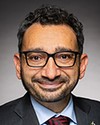Yes, those were my numbers, and that was me in the paper. I underestimated the number of procedures we were doing across those four hospitals. It was actually 90 procedures that we were doing a week.
In that first week, we did drop down to that number of 12. Fortunately, due to the tremendous efforts of my staff and also of our central radiopharmacy, we were able to bump that up and do a bit better in the second and third weeks of the crisis. We ended up doing about 40% to 50% of our workload, which was about what the rest of the centres who had access to product were doing.
I believe that by triaging we did all the tests we absolutely had to do. I think we got them all done in Hamilton. But I know that other centres literally shut their doors, and there were tests that didn't get done. There were patients who required lung scans for the diagnosis of pulmonary embolism where there was not access to CT services, and those studies didn't get done. I have not heard that those patients suffered any harm as a result of that.
Again, taking a step back to the diagnostic process, which begins with a patient complaint followed by a history and a physical and a good physician assessing what the risks and probabilities are, people make decisions in the absence of diagnostic tests. They don't just stand there and say, “I'm not going to do anything.” They treat people with the best ability they have.
To the best of my knowledge, I am not aware of any patient who actually died or suffered a serious event as a result of this crisis, because I think we were managing reasonably well up until the time Parliament acted and the reactor was turned back on.
Can I say for certain that didn't happen to anyone across North America? No, I can't say for certain that it didn't happen.



